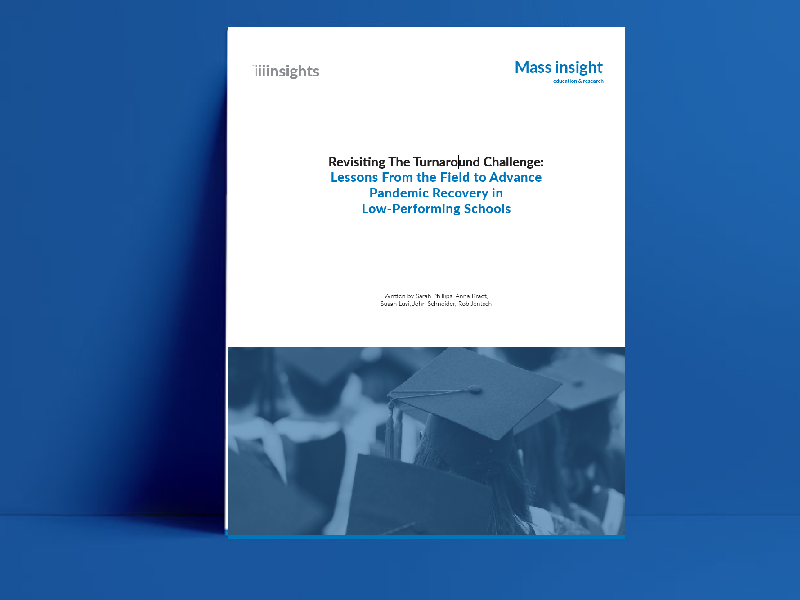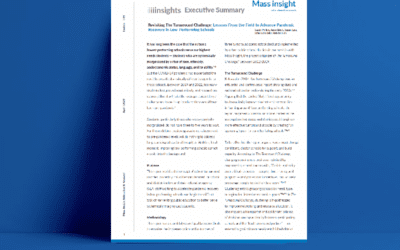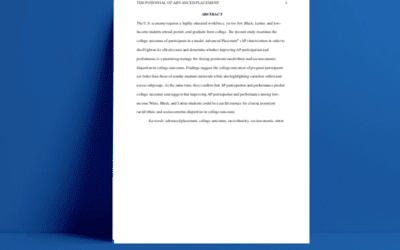The Boulder Fund grant will allow Mass Insight to pilot a new program targeting middle school readiness. May. 22, 2025 –Boston– Mass Insight Education & Research’s President and CEO, Andrea Wolfe, has been selected in the 2025 cohort of Education Leaders of...
Revisiting The Turnaround Challenge: Lessons From the Field to Advance Pandemic Recovery in Low-Performing Schools
It has long been the case that the nation’s lowest performing schools serve our highest needs students — students who are systemically marginalized by virtue of race, ethnicity, socioeconomic status, language, and/or ability. But the COVID-19 pandemic has exacerbated the need to provide dramatically different supports to these schools. Between 2019 and 2022, too many students lost ground academically, and researchers estimate that it will take the average student three to five years to catch up to where they would have been pre-pandemic. To download the Executive Summary highlighting key takeaways, click here.
Key Takeaways from this Insights Paper:
- The extent to which a district has established the conditions (time, people, money, and program) for school transformation seems to matter more than the strategies by which conditions change occurs.
- Those working to transform low-performing schools should focus on strategies for improving conditions that have the greatest likelihood of success in their local context.
- In addition to time, people, money, and program, district and zone climate should be added to the list of critical conditions to be leveraged or improved.
- The benefits of clustering appear related to the use of a spiderweb network model and the establishment of a zone office with the structure and authority to offer streamlined central office support/buffer zone schools.
- While resources may significantly improve student outcomes in the short-term, additional resources must be combined with other capacity-building strategies if they are to affect long-term student outcomes in low-performing schools.
- School and district leaders and SEA staff would do well to establish a clear focus and align their capacity building efforts to that focus.
Download the Resource
Lessons From the Field to Advance Pandemic Recovery in Low-Performing Schools

Recent Posts
Cybersecurity Event Introduces Students to Cyber Careers
For the 5th year in a row, Mass Insight Education & Research is hosting the Cybersecurity and You Workshop to introduce Advanced Placement® (AP) STEM high school students to cybersecurity scenarios and concepts as well as postsecondary education and career paths....
Adolescent Literacy Crisis: IES Guide In Action – Webinar
What does the evidence say about how schools can improve the adolescent literacy crisis happening in our country? In this webinar, we explore the Institute of Education Sciences Reading Intervention Guide for Grades 4 through 9, found here, and diving into two of the...
You may also like
All Over The Map: Massachusetts High School Graduation Requirements
A new report by the Voices for Academic Equity Coalition, of which Mass Insight is a founding member, unpacks the status of the state’s MassCore curriculum, a recommended opt-in course of study for the state’s high school students. Massachusetts currently has just...
Executive Summary: Revisiting The Turnaround Challenge
Our report, Revisiting The Turnaround Challenge: Lessons From the Field to Advance Pandemic Recovery in Low-Performing Schools, takes a look back at the Zone model presented in our seminal 2007 report, The Turnaround Challenge, and uses three anonymous district case...
The Potential of Advanced Placement to Improve College Outcomes and Narrow Racial/Ethnic and Socioeconomic Disparities
The Potential of Advanced Placement to Improve College Outcomes and Narrow Racial/Ethnic and Socioeconomic Disparities by Dr. Sarah Phillips and Brett Lane Published online in the June 2021 Journal of Advanced Academics, this paper describes how improving AP...


